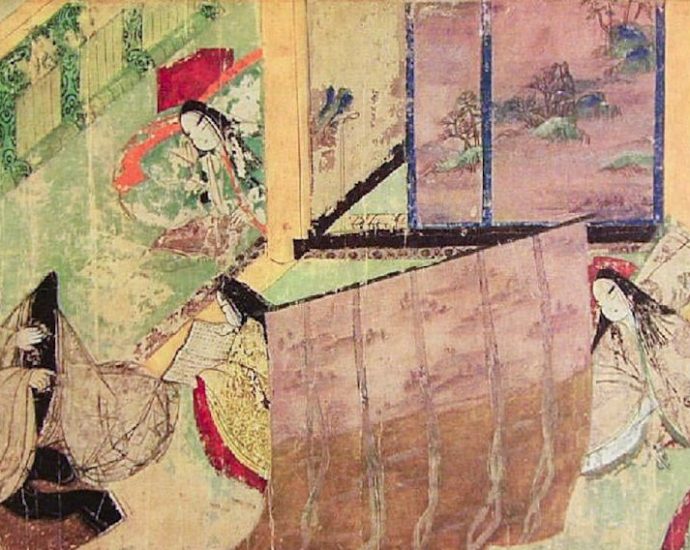Genji was read by women together in the intimate seclusion of a palace full of secret recesses, as in this early twelfth-century illustration of a scene from Chapter Fifty (Azumaya, “The Eastern Cottage”). Hiding in her half-sister’s apartments, Ukifune is having her hair dressed while amusing herself with illustrations of the tale which a servant reads her.
The landscape-screens were magic windows on distant scenes, which the inmates of the court were condemned never to see atfirsthand by the sedentary conventions of their way of life. Earlier sequences of illustrations to Genji certainly existed but have not survived.
Like the palace cats’, the eyes of the Lady Murasaki Shikibu were accustomed to the dark. The gloomy corridors of the vast complex of imperial buildings at Heian, where a wanderer could get waylaid or lost, were her home territory. The half-light in which Japanese court life was lived in the late tenth and early eleventh centuries concealed nothing from her stare, though the obscurity was deep enough to make stories of mistaken identity among lovers credible.
Her powers of observation produced The Tale of Genji, which has some claim to be the world’s first novel: Genjfs intricate realism, recorded with the restraint of a Jane Austen and the depth of reflection of a Proust, gave it in its day a popularity which it has never lost. It also makes it, as novels go, a work of unexcelled usefulness to historians, recalling faithfully the customs and values of a long-vanished world.
Appearing like a modern serial, bit by bit, over many years, Genji became a part of the culture it described, titillating and tantalizing readers who vied for manuscripts of unread chapters, stimulating gossip, and reinforcing the peculiar ideals of Heian, ideals which elevated poetry above prowess, beauty above brawn, and which esteemed a sensitive failure more highly than a coarse success.
Murasaki was only one of a drawerful of courtly bluestockings. Fiction writing, poetry, diaries, and “pillow books” were all common forms of divertissement for rich and intelligent women, who were free of economic constraints yet barred from public life. Without ever describing herself, she noted what she claimed was others’ perception of her: “pretty, yet shy; shrinking from sight; so wrapped up in poetry that other people hardly exist; spitefully looking down on the whole world.” The assessment was only partly right. Murasaki’s literary proclivities seem to have enhanced rather than displaced her interest in her fellow-courtiers; but her acuity could have been miscast as spite and her detachment mistaken for condescension. That Genji is virtually a roman à clef is hinted at by one of the characters, who confides how readers are inspired by “things both good and bad, which they have seen and heard happening to men and women and which they cannot keep all to themselves.”
Murasaki made her observations from a privileged vantage point. In 1002 a plague left her a young widow at court. By 1005 she was in the household of the emperor’s favourite consort, Shoshi. There she was courted, if her diary can be trusted, by the most powerful man in Japan, Shoshi’s father, Fujiwara no Michinaga, “with his tap-tap-tap upon the shutters like the cry of the kuina bird.”
Though excluded by her sex from the political stage, Murasaki had a grand view from the balcony.
Her suitor, whom she despised as a drunken lecher, was brother-in-law to two emperors, uncle and father-in-law to another, uncle to one more, and grandfather to two. Puppeteer of emperors’ womenfolk, informal arbiter of the succession, he was a classic mayor-of-the-palace or grand vizir figure who arrogated executive power to himself. Encumbered by ceremonial, emperors had to bid for real power by taking early retirement, usually in their twenties or early thirties. The household servants of the Fujiwara clan provided the empire with a working bureaucracy while the nominal officers of state were trapped in the trammels of ritual. Launched to power by an emperor’s affection for his niece, Fujiwara secured his position when his main rival was disgraced in a brawl with an ex-emperor over a lady’s favours. After the early and rapid deaths of three emperors in factional struggles, Fujiwara ruled through his grandson, Go-Ichijo (986-1022), elevated to the throne at the age of eight. The minister was borne up on a spiral of self-enrichment and enhanced power and left, according to one embittered voice, “not a speck of earth for the public domain.”
With a small purse and a large seraglio, emperors were embarrassingly philoprogenitive. Imperial princelings demoted for reasons of economy were accommodated in the Minamoto clan, known as the Gen-ji, and this is the predicament of the hero in Murasaki’s tale. Prince Genji is pre-eminent in every quality, but as a seducer he is nothing short of perfect; thus, though excluded from the throne that ought to have been his by merit, he is able to sire a race of emperors. His changing political fortunes form the backdrop of the book; yet it is not primarily a political novel but a chronicle of the loves and friendships of Genji and of the next generation of his family, a préfiguration of the soap opera in medieval Japan. The ruling irony lies not in Genji’s reversal of the injustice of the succession but in the fact that his own heir turns out to be a product of cuckoldry.
Still, it is impossible to see Murasaki, with her contempt for Fujiwara’s sexual overtures and her sympathy for the victims of dynastic manipulation, as other than the spokeswoman for the excluded brethren of a small but competitively riven political élite. This made her novel something of a succès de scandale; for its avid female readers it had a dorm-culture thrill, an anti-establishment tang. The “outs” of politics were consoled, in her world, by a system of values reminiscent of the British cult of the underdog and a sort of “Dunkirk spirit” that made a virtue of defeat. “The nobility of failure” 7was admired and sometimes deified in Murasaki’s Japan.
An earlier loser in an anti-Fujiwara power struggle, whose example may have helped to inform the character of the fictional Genji, was Sugawara no break the Fujiwara monopoly of authority; but a Fujiwara coup d’état in the year 901 sent him into provincial exile—a fate quite as bad as death in the intensely urban world of the Japanese metropolitan élite—and reduced him to “mere scum that floats upon the water’s face.” For years he was supposed to wreak vengeance on the ruling clan from beyond the grave and was only appeased by the formal proclamation of his apotheosis by a Fujiwara government ninety years later. Against this sort of background, a gutless and anaemic hero like Genji could have romantic appeal, as if the character of Hamlet could have the connotations of James Bond.
Another element of Sugawara’s story—the theme of supernatural blight and vengeful haunting—also pervades the atmosphere of Genji. The Japanese imagination in the tenth and eleventh centuries was alive with ghosts and demons: crude hobgoblins in lesser tales, personifications, in more sophisticated literature, of powerful emotions. In The Demon ofRasho Gate of 974, the authorities are baffled by the mysterious disappearance of several citizens of Heian, until a daring young man vows to patrol the danger zone. He is lulled by the beauty of a young girl who transforms herself into a hideous succubus. Escaping just in time, he severs her arm, which he keeps as a souvenir until it is carried off into the sky by the demon, who returns in disguise. In Genji the theme is more subtly handled but at least as strong. Genji’s jealous mistress, the Lady Rokujo, projects a hatred so intense that it envenoms Genji’s affairs with other women and, undiminished by the lady’s death, withers and kills his best-loved girl, like the worm in the bud.
Murasaki’s skill is such that she can interweave this sinister strand—crude warp of some primitive, rustic yarn—with the silken thread of her courtly tale, the soft stuff of a delicate comedy of manners. For Genji and his fellow-courtiers move with balletic grace, guided by a yearning for beauty, regulated by a hierarchy of rank, informed by refined sensibilities. Their ruling passion is Weltschmerz, and they are at their most admirable—their inventor admires them most—when they are saddened by fragile beauty or touched by the mutability of nature. The rules of rank in Heian make the Versailles of Saint-Simon seem like a free-for-all. Genji’s son’s dream was of the day when he would be able to discard the “hateful green robe” that signified his derogation to the sixth rank of the nobility. The emperor’s cat was favoured with the status and adorned with the coiffure of a lady of middle rank. A nurse could tell by the timbre of a visitor’s cough to what level of noblesse he belonged. Far more tension arises in the tale from the interplay of different levels of hierarchy than from the malign influence of Rokujo’s ghost. “Sometimes,” Genji observes, “people of high rank sink to the most abject positions; while others of common birth rise to be high of ficers, wear self-important faces, redecorate the insides of their houses, and think themselves as good as anyone.” Genji’s origins and misfortunes alike stemmed from what the court condemned as a mésalliance between an emperor and the daughter of a provincial official.
The perils of courtship in the provinces dominate the prolongation of the tale into the generation af
ter Genji’s. Parvenues could inspire fear or mirth—the provincial clod patchily adjusted to court life is a stock comic character—while cases of de cayed gentility could chill delicately nurtured palace spines: the chancel lor’s son who, out of favour in the capital, is a ragged laughing-stock; the “barefoot wandering minstrel the townspeople call The Justice’s Miss,” whose father was “a high official.” In Murasaki’s work, struggles for prece dence could be deliciously derided: she satirized the emulous vice of “car riage quarrels” in which ladies’ conveyances jostled one another in streets cluttered with status symbols at times of public spectacle. She makes fun of the palace dwellers banging their heads together and chipping their combs as they bounce over the sleeping policeman at the gate. This sort of humour thrilled precisely because it touched quarrels and contests of deadly earnest.
Even more than by their rank, Murasaki’s characters establish their places in her world by expressions of sensitivity. Her male heroes are excited to love by exquisite calligraphy, a girl by the “careless dexterity” of a folded note. In the opinion of Sei Shonagon, the court’s most accomplished expert on love, “a woman’s attachment to a man depends largely on the elegance of his leave-taking.” It was possible to buy or bludgeon one’s way to power, but social acceptability depended on one’s ability to extemporize verses, preferably in classical Chinese. The exchange of poems, couched in subtle, sometimes cryptic imagery, was the only way for social intercourse to escape the restraints of the formal and ritual conventions that proscribed explicit utterance and obscured the expression of feeling. One of Murasaki’s most heartfelt self-reproaches was at her failure to respond with a suitably aloof verse to one of Fujiwara’s passes.
The beauty and sensibility cultivated in the poems—and, in their written versions, the way they were formed and folded—was the object of every form of public display. Only in an archery contest do Genji and his friends approach the practical world of values of their European counterparts and contemporaries; their usual competitions are in painting, dancing, and mix ing perfumes and incense. The cult of delicacy of feeling is illustrated in Genji by the hero’s unwillingness to abandon the courtship of a princess who turns out—when seen close up—to be red-nosed and gawky, in a sort of pre-incarnation of the Code of the Woosters or of the bloodless refine ment that restrained Newland Archer in The Age of Innocence or the chivalry that obliged Wellington to marry Kitty Pakenham after she had grown “damn ugly.” In a different context, the same ideal explains the story of how Emperor Ichijo retired out of earshot when playing on his flute a pop pasquinade aimed at a low-born minister. In order to demonstrate sensitivity to the beauties of nature without venturing into the odious provinces, court officials built gardens in simulation of the “scenic won ders” praised by poets. Trees were trained into fantastic shapes to imitate the wind-bent pines of Amanohashidate.
In Christendom at the time, aristocratic thuggery had to be restrained or at least channelled by the church. Noble hoodlums would be at best slowly andfitfullycivilized over a long period by a cult of chivalry which always remained as much a training in arms as an education in values of gentility.
From this perspective the existence on the other side of the world of a cul ture in which delicacy of feeling and the arts of peace were spontaneously celebrated by a secular élite seems astonishing. So little work has been done, and so few sources are available, on the lower levels of society in the Japan of the Fujiwara that it is hard to say how oppressively this empire of sensibility ruled its subjects. Genji’s is a world of hard-paste porcelain in which no earthenware appears. No lower orders intrude to uglify; peasants are so unfamiliar as to loom only as “phantoms.” Heian was isolated not only from the rest of the world but also from its own hinterland, and the provinces saw paragons like Sugawara and Genji only in times of exile.
Most of the time they were ruled by the badly powdered men whose faces reminded Sei Shonagon of “dark earth over which snow has melted in patches.” The rice revenues which sustained the court aristocracy were extorted from a peasantry periodically winnowed by famine and plague. Though the imperial army was fit only for ceremonial and officered by sinecurists, the countryside was cowed by the retinues of provincial admin istrators—gangs of toughs and bravos licensed by authority, like the rurales of pre-revolutionary Mexico—which would evolve into the private armies of provincial aristocrats. In the next century they would challenge and eventually overthrow the central power.
Still, what is remarkable is not that the values of the court should have remained unreflected in the country but that they should have existed at all in so refined a form. Even in Genji, some characters evince impatience with the conventions of courtly behaviour. In an appeal to “the spirit of Japan” or a rejection of traditional “Chinesified” art as “simpering,” it is tempting to suppose some sort of préfiguration of the practical, martial Japan familiar from a later era. Yet hindsight is a highly refractive lens, and all that survives of the art and literature of the late tenth and early eleventh centuries is remarkably consistent in sustaining the impression of a collective project of self-restraint.
The art of Heian, like that of the Italian Renaissance, seems actively to reject the emotional self-indulgence and strenuous asperities of preceding eras in favour of moderation and sprezzatura. The style was de fined for traditional critics by the sculptor Jocho, who decorated the palace of Hojoji for Fujiwara no Michinaga. His divine and heroic images, human, realistic, and placid, set the tone for the rest of the century. The effects of this taste can be admired, for instance, in the Daiitoku of Boston Museum, with his human head and limbs and calculated renunciation of horror, or in the wood carving of Prince Shotoku, made by the sculptor Enkai in 1069, unstamped by passion. Genji might have been at home in Gonzaga Man tua, or Castiglione welcome in Heian.








